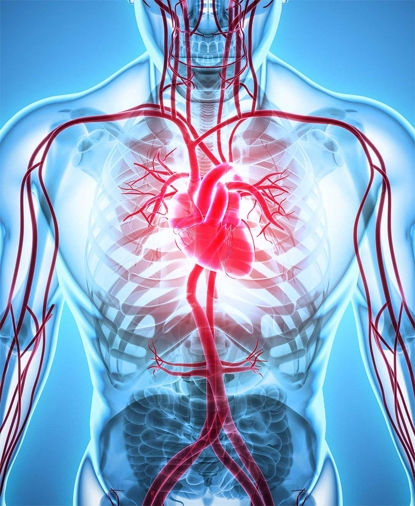Ask a Doctor: All About Vascular Disease
Nov 28, 2023

Your hard-working heart pumps blood throughout your body through a network of blood vessels that are known as your vascular system. The vascular system includes your arteries, veins and capillaries, which each have their own role in carrying blood into every part of your body and back to your heart again.
There are several conditions that can affect this important system. Bader Ghalyoun, MD, an interventional cardiologist with Adventist Health Lodi Memorial, answers the top questions about vascular disease.
What is vascular disease?
Vascular disease encompasses a broad spectrum of disorders that affect the network of blood vessels in the body, which includes the arteries, veins, and capillaries. These diseases can range from peripheral artery disease (PAD), where narrowed arteries reduce blood flow to the limbs, to aneurysms, which involve the abnormal enlargement of blood vessels. Vascular diseases disrupt the normal flow of blood, either by blocking or weakening blood vessels, or by damaging the valves that are found in veins.
Risk factors contributing to vascular diseases are manifold, including high blood pressure, diabetes, high cholesterol, and smoking. These conditions can lead to atherosclerosis, a common vascular disease where arteries harden due to the buildup of plaque, making it challenging for blood to flow through the vessels. Lifestyle and genetic predisposition also play pivotal roles in the onset and progression of vascular diseases.
How is vascular disease detected?
Detection strategies are essential for early identification of vascular diseases, enabling timely intervention and management. Regular consultations with healthcare professionals, awareness of symptoms, and appropriate diagnostic tests are pivotal in the effective detection of these conditions.
Physical Exam: Doctors may start with a physical exam and consider medical history. Checking pulses in your limbs and blood pressure in different areas might be included.
Diagnostic Tests:
- ABI (Ankle-Brachial Index): An Ankle-Brachial Index (ABI) test is a simple, non-invasive diagnostic procedure used to assess the presence and severity of peripheral arterial disease (PAD). The ABI test compares the blood pressure in the ankles to the blood pressure in the arms to determine how well the blood is flowing and whether there are any signs of blockage.
- Ultrasound: Non-invasive test to visualize blood vessels and assess blood flow.
- Angiography: A special X-ray test to view blood vessels and identify abnormalities.
- Blood Tests: Conducted to assess cholesterol levels, blood sugar levels, and other markers.
- Advanced Imaging Techniques:
- MRI and CT scans can be used for detailed images of blood vessels.
- These tests can help in diagnosing various vascular diseases.
Blood Pressure Monitoring: Regularly checking blood pressure, as high levels are a significant risk factor. Keeping blood pressure within recommended ranges through lifestyle and medication if necessary.
Symptom Awareness: Being aware of signs such as unexplained pain or cramps, often in the legs mainly with exercise that improves at rest (claudication). Noticing changes in the color or temperature of legs or arms.
Regular Screenings for At-risk Individuals: People with risk factors like smoking, diabetes, and a family history of vascular diseases should undergo more frequent screenings. Specific tests based on individual risk profiles and family history.
Pulse Checks: Checking the pulses in various parts of the body to ensure adequate blood flow. An irregular pulse may indicate a vascular issue.
Consultation and Expert Advice: Discussing symptoms and concerns with healthcare professionals. Seeking expert advice for proper diagnostic procedures based on symptoms and risk factors.
What can someone do to reduce their risk for vascular disease?
Taking care of your vascular health involves simple yet powerful steps that anyone can incorporate into their daily lives to reduce the risk of vascular diseases. Following these guidelines will not only help reduce the risk of vascular diseases but also contribute to overall well-being and health longevity.
Here’s a straightforward guide to help:
1. Eat a Balanced Diet
- Include a variety of fruits, vegetables, whole grains, and lean proteins in your meals.
- Limit the intake of saturated fats, salt, and added sugars.
2. Exercise Regularly
- Engage in physical activity like walking, cycling, or swimming for at least 150 minutes a week.
- If new to exercise, start slowly and gradually increase the duration and intensity.
3. Maintain a Healthy Weight
- Try to keep your weight within a healthy range to avoid putting extra pressure on your heart and blood vessels.
- Consult a healthcare professional for guidance on a weight that’s right for you.
4. Quit Smoking
- Smoking is a significant risk factor for vascular diseases. If you smoke, seek help to quit.
- Avoid exposure to secondhand smoke as well.
5. Limit Alcohol Consumption
- If you choose to drink alcohol, do so in moderation.
- Guidelines generally recommend up to one drink a day for women and up to two drinks a day for men.
6. Manage Stress
- Practice stress-relieving activities like yoga, meditation, or deep breathing exercises.
- Ensure you get adequate sleep and rest.
7. Regular Health Check-ups
- Regularly monitor your blood pressure, cholesterol levels, and diabetes.
- Consult your doctor for personalized advice based on your health status.
8. Stay Informed
- Stay updated with accurate information on vascular health.
- Don’t hesitate to ask your healthcare provider questions about your vascular health and risk factors.
What are the treatment options for vascular disease?
If you’ve been diagnosed with a vascular disease, your healthcare provider will partner with you to treat the condition. There are a number of effective options that may be part of your treatment plan.
Lifestyle Modifications: This could include adopting a heart-healthy diet rich in fruits, vegetables, and whole grains and regular exercise to maintain optimal body weight and improve circulation.
Medication Management: Prescriptions may include antihypertensive drugs to manage high blood pressure, cholesterol-lowering medications (such as statins) to manage lipid levels, or blood thinners to prevent clots like aspirin.
Interventional Procedures: Your provider may recommend angioplasty to open narrowed blood vessels, stenting to keep blood vessels open, or bypass surgery to reroute blood around blocked arteries.
Regular Monitoring and Follow-up: It’s important to continue working with your healthcare provider, including consistent monitoring of blood pressure, cholesterol, and other vascular health indicators. Routine follow-ups with healthcare professionals will help ensure ongoing management of a vascular condition.


